Chapter 11 Three Dimensional Geometry
The moving power of mathematical invention is not reasoning but imagination. - A.DEMORGAN
11.1 Introduction
In Class XI, while studying Analytical Geometry in two dimensions, and the introduction to three dimensional geometry, we confined to the Cartesian methods only. In the previous chapter of this book, we have studied some basic concepts of vectors. We will now use vector algebra to three dimensional geometry. The purpose of this approach to 3-dimensional geometry is that it makes the study simple and elegant*.
In this chapter, we shall study the direction cosines and direction ratios of a line joining two points and also discuss about the equations of lines and planes in space under different conditions, angle between two lines, two planes, a line and a plane, shortest distance between two skew lines and distance of a point from a plane. Most of the above results are obtained in vector form. Nevertheless, we shall also translate these results in the Cartesian form which, at times, presents a more clear geometric and analytic picture of the situation.

Leonhard Euler $(\mathbf{1 7 0 7 - 1 7 8 3 })$
11.2 Direction Cosines and Direction Ratios of a Line
From Chapter 10, recall that if a directed line $L$ passing through the origin makes angles $\alpha, \beta$ and $\gamma$ with $x, y$ and $z$-axes, respectively, called direction angles, then cosine of these angles, namely, $\cos \alpha, \cos \beta$ and $\cos \gamma$ are called direction cosines of the directed line $L$.
If we reverse the direction of $L$, then the direction angles are replaced by their supplements, i.e., $\pi-\alpha, \pi-\beta$ and $\pi-\gamma$. Thus, the signs of the direction cosines are reversed.
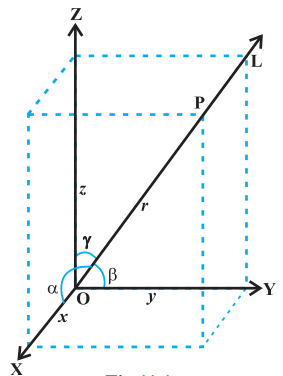
Fig 11.1
Note that a given line in space can be extended in two opposite directions and so it has two sets of direction cosines. In order to have a unique set of direction cosines for a given line in space, we must take the given line as a directed line. These unique direction cosines are denoted by $l, m$ and $n$.
Remark If the given line in space does not pass through the origin, then, in order to find its direction cosines, we draw a line through the origin and parallel to the given line. Now take one of the directed lines from the origin and find its direction cosines as two parallel line have same set of direction cosines.
Any three numbers which are proportional to the direction cosines of a line are called the direction ratios of the line. If $l, m, n$ are direction cosines and $a, b, c$ are direction ratios of a line, then $a=\lambda l, b=\lambda m$ and $c=\lambda n$, for any nonzero $\lambda \in \mathbf{R}$.
Note Some authors also call direction ratios as direction numbers.
Let $a, b, c$ be direction ratios of a line and let $l, m$ and $n$ be the direction cosines (d.c’s) of the line. Then
$$ \frac{l}{a}=\frac{m}{b}=\frac{n}{c}=k \text{ (say), } k \text{ being a constant. } $$
Therefore $ \qquad l=a k, m=b k, n=c k $
But $ \qquad l^{2}+m^{2}+n^{2}=1 $
Therefore $ \qquad k^{2}(a^{2}+b^{2}+c^{2})=1 $
or $ \qquad k= \pm \frac{1}{\sqrt{a^{2}+b^{2}+c^{2}}} $
Hence, from (1), the d.c.’s of the line are $ \qquad l= \pm \frac{a}{\sqrt{a^{2}+b^{2}+c^{2}}}, m= \pm \frac{b}{\sqrt{a^{2}+b^{2}+c^{2}}}, n= \pm \frac{c}{\sqrt{a^{2}+b^{2}+c^{2}}} $
where, depending on the desired sign of $k$, either a positive or a negative sign is to be taken for $l, m$ and $n$. For any line, if $a, b, c$ are direction ratios of a line, then $k a, k b, k c ; k \neq 0$ is also a set of direction ratios. So, any two sets of direction ratios of a line are also proportional. Also, for any line there are infinitely many sets of direction ratios.
11.2.1 Direction cosines of a line passing through two points
Since one and only one line passes through two given points, we can determine the direction cosines of a line passing through the given points $P(x_1, y_1, z_1)$ and $Q(x_2, y_2, z_2)$ as follows (Fig 11.2 (a)).
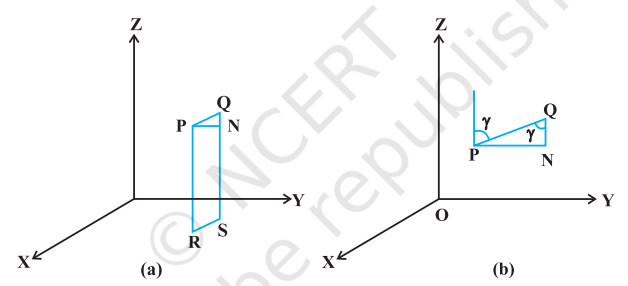
Fig 11.2
Let $l, m, n$ be the direction cosines of the line PQ and let it makes angles $\alpha, \beta$ and $\gamma$ with the $x, y$ and $z$-axis, respectively.
Draw perpendiculars from $P$ and $Q$ to $XY$-plane to meet at $R$ and $S$. Draw a perpendicular from $P$ to $QS$ to meet at $N$. Now, in right angle triangle $PNQ, \angle PQN=\gamma$ (Fig 11.2 (b)).
$$ \begin{aligned} & \cos \gamma=\frac{\mathrm{NQ}}{\mathrm{PQ}}=\frac{z _{2}-z _{1}}{\mathrm{PQ}} \\ & \cos \alpha=\frac{x _{2}-x _{1}}{\mathrm{PQ}} \text { और } \cos \beta=\frac{y _{2}-y _{1}}{\mathrm{PQ}} \end{aligned} $$
Therefore Hence, the direction cosines of the line segment joining the points $P(x_1, y_1, z_1)$ and $Q(x_2, y_2, z_2)$ are
$$ \frac{x_2-x_1}{PQ}, \frac{y_2-y_1}{PQ}, \frac{z_2-z_1}{PQ} $$
where $ \qquad PQ=\sqrt{(x_2-x_1)^{2}+(y_2-y_1)^{2}+(z_2-z_1)^{2}} $
Note The direction ratios of the line segment joining $P(x_1, y_1, z_1)$ and $Q(x_2, y_2, z_2)$ may be taken as
$$ x_2-x_1, y_2-y_1, z_2-z_1 \text{ or } x_1-x_2, y_1-y_2, z_1-z_2 $$
Example 1 If a line makes angle $90^{\circ}, 60^{\circ}$ and $30^{\circ}$ with the positive direction of $x, y$ and $z$-axis respectively, find its direction cosines.
Solution Let the $d . c$. ’ $s$ of the lines be $l, m, n$. Then $l=\cos 90^{\circ}=0, m=\cos 60^{\circ}=\frac{1}{2}$, $n=\cos 30^{\circ}=\frac{\sqrt{3}}{2}$.
Example 2 If a line has direction ratios 2, - 1, - 2, determine its direction cosines.
Solution Direction cosines are
$$ \frac{2}{\sqrt{2^{2}+(-1)^{2}+(-2)^{2}}}, \frac{-1}{\sqrt{2^{2}+(-1)^{2}+(-2)^{2}}}, \frac{-2}{\sqrt{2^{2}+(-1)^{2}+(-2)^{2}}} $$
or $\qquad \frac{2}{3}, \frac{-1}{3}, \frac{-2}{3}$
Example 3 Find the direction cosines of the line passing through the two points $(-2,4,-5)$ and $(1,2,3)$.
Solution We know the direction cosines of the line passing through two points $P(x_1, y_1, z_1)$ and $Q(x_2, y_2, z_2)$ are given by
where $ \qquad \frac{x_2-x_1}{PQ}, \frac{y_2-y_1}{PQ}, \frac{z_2-z_1}{PQ} $
$$ PQ=\sqrt{(x_2-x_1)^{2}+(y_2-y_1)^{2}+(z_2-z_1)^{2}} $$
Here $P$ is $(-2,4,-5)$ and $Q$ is $(1,2,3)$.
So $ \qquad P Q=\sqrt{(1-(-2))^{2}+(2-4)^{2}+(3-(-5))^{2}}=\sqrt{77} $
Thus, the direction cosines of the line joining two points is
$ \qquad \frac{3}{\sqrt{77}}, \frac{-2}{\sqrt{77}}, \frac{8}{\sqrt{77}} $
Example 4 Find the direction cosines of $x, y$ and $z$-axis.
Solution The $x$-axis makes angles $0^{\circ}, 90^{\circ}$ and $90^{\circ}$ respectively with $x, y$ and $z$-axis. Therefore, the direction cosines of $x$-axis are $\cos 0^{\circ}, \cos 90^{\circ}, \cos 90^{\circ}$ i.e., $1,0,0$. Similarly, direction cosines of $y$-axis and $z$-axis are $0,1,0$ and $0,0,1$ respectively.
Example 5 Show that the points A $(2,3,-4), B(1,-2,3)$ and $C(3,8,-11)$ are collinear.
Solution Direction ratios of line joining A and B are
$1-2,-2-3,3+4$ i.e., $-1,-5,7$.
The direction ratios of line joining $B$ and $C$ are $3-1,8+2,-11-3$, i.e., $2,10,-14$.
It is clear that direction ratios of $AB$ and $BC$ are proportional, hence, $AB$ is parallel to $BC$. But point $B$ is common to both $AB$ and $BC$. Therefore, $A, B, C$ are collinear points.
EXERCISE 11.1
1. If a line makes angles $90^{\circ}, 135^{\circ}, 45^{\circ}$ with the $x, y$ and $z$-axes respectively, find its direction cosines.
Show Answer
Solution
Let direction cosines of the line be $l, m$, and $n$.
$l=\cos 90^{\circ}=0$
$m=\cos 135^{\circ}=-\frac{1}{\sqrt{2}}$
$n=\cos 45^{\circ}=\frac{1}{\sqrt{2}}$
Therefore, the direction cosines of the line are $0,-\frac{1}{\sqrt{2}}$, and $\frac{1}{\sqrt{2}}$.
2. Find the direction cosines of a line which makes equal angles with the coordinate axes.
Show Answer
Solution
Let the direction cosines of the line make an angle $a$ with each of the coordinate axes.
$\therefore l=\cos a, m=\cos a, n=\cos a$
$ \begin{aligned} & l^{2}+m^{2}+n^{2}=1 \\ & \Rightarrow \cos ^{2} \alpha+\cos ^{2} \alpha+\cos ^{2} \alpha=1 \\ & \Rightarrow 3 \cos ^{2} \alpha=1 \\ & \Rightarrow \cos ^{2} \alpha=\frac{1}{3} \\ & \Rightarrow \cos \alpha= \pm \frac{1}{\sqrt{3}} \end{aligned} $
Thus, the direction cosines of the line, which is equally inclined to the coordinate axes,
are $\pm \frac{1}{\sqrt{3}}, \pm \frac{1}{\sqrt{3}}$, and $\pm \frac{1}{\sqrt{3}}$.
3. If a line has the direction ratios $-18,12,-4$, then what are its direction cosines?
Show Answer
Solution
If a line has direction ratios of $-18,12$, and -4 , then its direction cosines are
$\frac{-18}{\sqrt{(-18)^{2}+(12)^{2}+(-4)^{2}}}, \frac{12}{\sqrt{(-18)^{2}+(12)^{2}+(-4)^{2}}}, \frac{-4}{\sqrt{(-18)^{2}+(12)^{2}+(-4)^{2}}}$
i.e., $\frac{-18}{22}, \frac{12}{22}, \frac{-4}{22}$
$\frac{-9}{11}, \frac{6}{11}, \frac{-2}{11}$
Thus, the direction cosines are $-\frac{9}{11}, \frac{6}{11}$, and $\frac{-2}{11}$.
4. Show that the points $(2,3,4),(-1,-2,1),(5,8,7)$ are collinear.
Show Answer
Solution
The given points are $A(2,3,4), B(-1,-2,1)$, and $C(5,8,7)$.
It is known that the direction ratios of line joining the points, $(x_1, y_1, z_1)$ and $(x_2, y_2, z_2)$, are given by, $x_2-x_1, y_2-y_1$, and $z_2-z_1$.
The direction ratios of $A B$ are $(-1-2),(-2-3)$, and $(1-4)$ i.e., $-3,-5$, and -3 . The direction ratios of $BC$ are $(5-(-1)),(8-(-2))$, and $(7-1)$ i.e., 6,10 , and 6 . It can be seen that the direction ratios of $B C$ are -2 times that of $A B$ i.e., they are proportional.
Therefore, $A B$ is parallel to $B C$. Since point $B$ is common to both $A B$ and $B C$, points $A, B$, and $C$ are collinear.
5. Find the direction cosines of the sides of the triangle whose vertices are $(3,5,-4),(-1,1,2)$ and $(-5,-5,-2)$.
Show Answer
Solution
The vertices of $\triangle A B C$ are $A(3,5,-4), B(-1,1,2)$, and $C(-5,-5,-2)$.
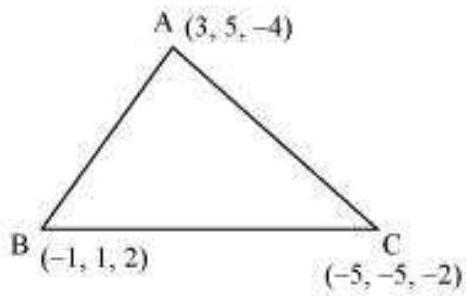
The direction ratios of side $A B$ are $(-1-3),(1-5)$, and $(2-(-4))$ i.e., $-4,-4$, and 6 .
Then, $\sqrt{(-4)^{2}+(-4)^{2}+(6)^{2}}=\sqrt{16+16+36}$
$ \begin{aligned} & =\sqrt{68} \\ & =2 \sqrt{17} \end{aligned} $
Therefore, the direction cosines of $A B$ are
$ \begin{aligned} & \frac{-4}{\sqrt{(-4)^{2}+(-4)^{2}+(6)^{2}}}, \frac{-4}{\sqrt{(-4)^{2}+(-4)^{2}+(6)^{2}}}, \frac{6}{\sqrt{(-4)^{2}+(-4)^{2}+(6)^{2}}} \\ & \frac{-4}{2 \sqrt{17}},-\frac{4}{2 \sqrt{17}}, \frac{6}{2 \sqrt{17}} \\ & \frac{-2}{\sqrt{17}}, \frac{-2}{\sqrt{17}}, \frac{3}{\sqrt{17}} \end{aligned} $
The direction ratios of $BC$ are $(-5-(-1)),(-5-1)$, and $(-2-2)$ i.e., $-4,-6$, and -4 . Therefore, the direction cosines of $B C$ are
$ \begin{aligned} & \frac{-4}{\sqrt{(-4)^{2}+(-6)^{2}+(-4)^{2}}}, \frac{-6}{\sqrt{(-4)^{2}+(-6)^{2}+(-4)^{2}}}, \frac{-4}{\sqrt{(-4)^{2}+(-6)^{2}+(-4)^{2}}} \\ & \text{ i.e., } \frac{-4}{2 \sqrt{17}}, \frac{-6}{2 \sqrt{17}}, \frac{-4}{2 \sqrt{17}} \end{aligned} $
The direction ratios of CA are $(-5-3),(-5-5)$, and $(-2-(-4))$ i.e., $-8,-10$, and 2 . Therefore, the direction cosines of $A C$ are
$ \begin{aligned} & \frac{-8}{\sqrt{(-8)^{2}+(10)^{2}+(2)^{2}}}, \frac{-5}{\sqrt{(-8)^{2}+(10)^{2}+(2)^{2}}}, \frac{2}{\sqrt{(-8)^{2}+(10)^{2}+(2)^{2}}} \\ & \text{ i.e., } \frac{-8}{2 \sqrt{42}}, \frac{-10}{2 \sqrt{42}}, \frac{2}{2 \sqrt{42}} \end{aligned} $
11.3 Equation of a Line in Space
We have studied equation of lines in two dimensions in Class XI, we shall now study the vector and cartesian equations of a line in space.
A line is uniquely determined if
(i) it passes through a given point and has given direction, or
(ii) it passes through two given points.
11.3.1 Equation of a line through a given point and parallel to $\vec{a}$ given vector $\vec{b}$
Let $\vec{a}$ be the position vector of the given point A with respect to the origin $O$ of the rectangular coordinate system. Let $l$ be the line which passes through the point $A$ and is parallel to a given vector $\vec{b}$. Let $\vec{r}$ be the position vector of an arbitrary point $P$ on the line (Fig 11.3).
Then $\overrightarrow{{}AP}$ is parallel to the vector $\vec{b}$, i.e., $\overrightarrow{{}AP}=\lambda \vec{b}$, where $\lambda$ is some real number.
But $$ \overrightarrow{{}AP}=\overrightarrow{{}OP}-\overrightarrow{{}OA} $$
i.e. $$\lambda \vec{b}=\vec{r}-\vec{a}$$
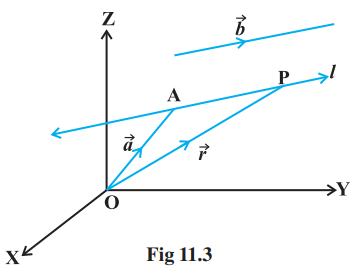
Conversely, for each value of the parameter $\lambda$, this equation gives the position vector of a point $P$ on the line. Hence, the vector equation of the line is given by
$$ \begin{equation*} \vec{r}=\vec{a}+\lambda \vec{b} \tag{1} \end{equation*} $$
Remark If $\vec{b}=a \hat{i}+b \hat{j}+c \hat{k}$, then $a, b, c$ are direction ratios of the line and conversely, if $a, b, c$ are direction ratios of a line, then $\vec{b}=a \hat{i}+b \hat{j}+c \hat{k}$ will be the parallel to the line. Here, $b$ should not be confused with $|\vec{b}|$. Derivation of cartesian form from vector form
Let the coordinates of the given point $A$ be $(x_1, y_1, z_1)$ and the direction ratios of the line be $a, b, c$. Consider the coordinates of any point $P$ be $(x, y, z)$. Then
$$ \overrightarrow{{}r}=x \hat{i}+y \hat{j}+z \hat{k} ; \overrightarrow{{}a}=x_1 \hat{i}+y_1 \hat{j}+z_1 \hat{k} $$
and $$ \vec{b}=a \hat{i}+b \hat{j}+c \hat{k} $$
Substituting these values in (1) and equating the coefficients of $\hat{i}, \hat{j}$ and $\hat{k}$, we get
$$ \begin{equation*} x=x _{1}+\lambda a ; \quad y=y _{1}+\lambda b ;\quad z=z _{1}+\lambda c \tag{2} \end{equation*} $$
These are parametric equations of the line. Eliminating the parameter $\lambda$ from (2), we get
$$ \begin{equation*} \frac{x-x _{1}}{a}=\frac{y-y _{1}}{b}=\frac{z-z _{1}}{c} \tag{3} \end{equation*} $$
This is the Cartesian equation of the line.
Note If $l, m, n$ are the direction cosines of the line, the equation of the line is
$$ \frac{x-x_1}{l}=\frac{y-y_1}{m}=\frac{z-z_1}{n} $$
Example 6 Find the vector and the Cartesian equations of the line through the point $(5,2,-4)$ and which is parallel to the vector $3 \hat{i}+2 \hat{j}-8 \hat{k}$.
Solution We have
$$ \vec{a}=5 \hat{i}+2 \hat{j}-4 \hat{k} \text{ and } \vec{b}=3 \hat{i}+2 \hat{j}-8 \hat{k} $$
Therefore, the vector equation of the line is
$$ \vec{r}=5 \hat{i}+2 \hat{j}-4 \hat{k}+\lambda(3 \hat{i}+2 \hat{j}-8 \hat{k}) $$
Now, $\vec{r}$ is the position vector of any point $P(x, y, z)$ on the line.
Therefore, $$\quad x \hat{i}+y \hat{j}+z \hat{k}=5 \hat{i}+2 \hat{j}-4 \hat{k}+\lambda(3 \hat{i}+2 \hat{j}-8 \hat{k})$$ $$ =(5+3 \lambda) \hat{i}+(2+2 \lambda) \hat{j}+(-4-8 \lambda) \hat{k} $$
Eliminating $\lambda$, we get
$$ \frac{x-5}{3}=\frac{y-2}{2}=\frac{z+4}{-8} $$
which is the equation of the line in Cartesian form.
11.4 Angle between Two Lines
Let $L_1$ and $L_2$ be two lines passing through the origin and with direction ratios $a_1, b_1, c_1$ and $a_2, b_2, c_2$, respectively. Let $P$ be a point on $L_1$ and $Q$ be a point on $L_2$. Consider the directed lines $OP$ and $OQ$ as given in Fig 11.6. Let $\theta$ be the acute angle between OP and OQ. Now recall that the directed line segments OP and OQ are vectors with components $a_1, b_1, c_1$ and $a_2, b_2, c_2$, respectively. Therefore, the angle $\theta$ between them is given by $\cos \theta=\left|\frac{a _{1} a _{2}+b _{1} b _{2}+c _{1} c _{2}}{\sqrt{a _{1}^{2}+b _{1}^{2}+c _{1}^{2}} \sqrt{a _{2}^{2}+b _{2}^{2}+c _{2}^{2}}}\right|$
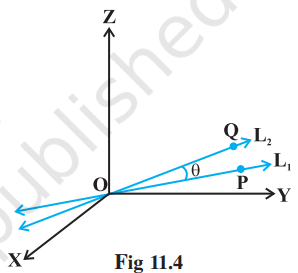
The angle between the lines in terms of $\sin \theta$ is given by
$$ \begin{aligned} \sin \theta & =\sqrt{1-\cos ^{2} \theta} \\ & =\sqrt{1-\frac{(a_1 a_2+b_1 b_2+c_1 c_2)^{2}}{(a_1^{2}+b_1^{2}+c_1^{2})(a_2^{2}+b_2^{2}+c_2^{2})}} \\ & =\frac{\sqrt{(a_1^{2}+b_1^{2}+c_1^{2})(a_2^{2}+b_2^{2}+c_2^{2})-(a_1 a_2+b_1 b_2+c_1 c_2)^{2}}}{\sqrt{(a_1^{2}+b_1^{2}+c_1^{2})} \sqrt{(a_2^{2}+b_2^{2}+c_2^{2})}} \\ & =\frac{\sqrt{(a_1 b_2-a_2 b_1)^{2}+(b_1 c_2-b_2 c_1)^{2}+(c_1 a_2-c_2 a_1)^{2}}}{\sqrt{a_1^{2}+b_1^{2}+c_1^{2}} \sqrt{a_2^{2}+b_2^{2}+c_2^{2}}} \end{aligned} $$
Note In case the lines $L_1$ and $L_2$ do not pass through the origin, we may take lines $L_1^{\prime}$ and $L_2^{\prime}$ which are parallel to $L_1$ and $L_2$ respectively and pass through the origin.
If instead of direction ratios for the lines $L_1$ and $L_2$, direction cosines, namely, $l_1, m_1, n_1$ for $L_1$ and $l_2, m_2, n_2$ for $L_2$ are given, then (1) and (2) takes the following form:
$$ \cos \theta=|l_1 l_2+m_1 m_2+n_1 n_2| \quad(\text{ as } l_1^{2}+m_1^{2}+n_1^{2}=1=l_2^{2}+m_2^{2}+n_2^{2}) $$
and $$ \sin \theta=\sqrt{(l_1 m_2-l_2 m_1)^{2}-(m_1 n_2-m_2 n_1)^{2}+(n_1 l_2-n_2 l_1)^{2}} $$
Two lines with direction ratios $a_1, b_1, c_1$ and $a_2, b_2, c_2$ are
(i) perpendicular i.e. if $\theta=90^{\circ}$ by (1)
$$ a_1 a_2+b_1 b_2+c_1 c_2=0 $$
(ii) parallel i.e. if $\theta=0$ by (2)
$$\frac{\boldsymbol{a} _{\mathbf{1}}}{\boldsymbol{a} _{2}}=\frac{\boldsymbol{b} _{\mathbf{1}}}{\boldsymbol{b} _{\mathbf{2}}}=\frac{\boldsymbol{c} _{\mathbf{1}}}{\boldsymbol{c} _{\mathbf{2}}}$$
Now, we find the angle between two lines when their equations are given. If $\theta$ is acute the angle between the lines $\vec{r}=\vec{a} _{1}+\lambda \vec{b} _{1}$ और $\vec{r}=\vec{a} _{2}+\mu \vec{b} _{2}$ In Cartesian form, if $\theta$ is the angle between the lines
then
$$
\begin{aligned}
\cos \theta & =\left|\frac{\vec{b}_1 \cdot \vec{b}_2}{\left|\vec{b}_1\right|\left|\vec{b}_2\right|}\right|
\end{aligned}
$$
$$ \frac{x-x_1}{a_1}=\frac{y-y_1}{b_1}=\frac{z-z_1}{c_1} \tag{1} $$
and $$ \frac{x-x_2}{a_2}=\frac{y-y_2}{b_2}=\frac{z-z_2}{c_2} \tag{2} $$
where, $a_1, b _{1,} c_1$ and $a _{2,}, b_2, c_2$ are the direction ratios of the lines (1) and (2), respectively, then
$$ \cos \theta=|\frac{a_1 a_2+b_1 b_2+c_1 c_2}{\sqrt{a_1^{2}+b_1^{2}+c_1^{2}} \sqrt{a_2^{2}+b_2^{2}+c_2^{2}}}| $$
Example 7 Find the angle between the pair of lines given by
$$ \vec{r}=3 \hat{i}+2 \hat{j}-4 \hat{k}+\lambda(\hat{i}+2 \hat{j}+2 \hat{k}) $$
and $$ \vec{r}=5 \hat{i}-2 \hat{j}+\mu(3 \hat{i}+2 \hat{j}+6 \hat{k}) $$
Solution Here $ \vec{b} _ {1}=\hat{i} + 2 \hat{j} + 2 \hat{k} $ and $ \vec{b} _ {2}=3 \hat{i} + 2 \hat{j} + 6 \hat{k} $
The angle $\theta$ between the two lines is given by
$$ \begin{aligned} \cos \theta & = |\frac{ \vec{b} _ {1} \cdot \vec{b} _ {2}}{| \vec{b} _ {1}|| \vec{b} _ {2}|}| = |\frac{(\hat{i} + 2 \hat{j} + 2 \hat{k}) \cdot(3 \hat{i} + 2 \hat{j} + 6 \hat{k})}{\sqrt{1 + 4+ 4} \sqrt{9 + 4 + 36}}| \\ & =|\frac{3+4+12}{3 \times 7}|=\frac{19}{21} ) \end{aligned} $$
Hence $$ \theta=\cos ^{-1}\left(\frac{19}{21}\right) $$
Example 8 Find the angle between the pair of lines
and $$ \begin{aligned} & \frac{x+3}{3}=\frac{y-1}{5}=\frac{z+3}{4} \\ & \frac{x+1}{1}=\frac{y-4}{1}=\frac{z-5}{2} \end{aligned} $$
Solution The direction ratios of the first line are 3, 5, 4 and the direction ratios of the second line are $1,1,2$. If $\theta$ is the angle between them, then
$$ \cos \theta=|\frac{3.1+5.1+4.2}{\sqrt{3^{2}+5^{2}+4^{2}} \sqrt{1^{2}+1^{2}+2^{2}}}|=\frac{16}{\sqrt{50} \sqrt{6}}=\frac{16}{5 \sqrt{2} \sqrt{6}}=\frac{8 \sqrt{3}}{15} $$
Hence, the required angle is $\cos ^{-1}(\frac{8 \sqrt{3}}{15})$.
11.5 Shortest Distance between Two Lines
If two lines in space intersect at a point, then the shortest distance between them is zero. Also, if two lines in space are parallel, then the shortest distance between them will be the perpendicular distance, i.e. the length of the perpendicular drawn from a point on one line onto the other line.
Further, in a space, there are lines which are neither intersecting nor parallel. In fact, such pair of lines are non coplanar and are called skew lines. For example, let us consider a room of size 1, 3, 2 units along
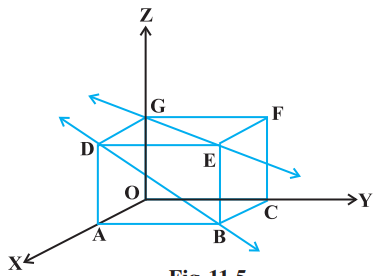
Fig 11.5 $x, y$ and $z$-axes respectively Fig 11.5.
The line GE that goes diagonally across the ceiling and the line DB passes through one corner of the ceiling directly above A and goes diagonally down the wall. These lines are skew because they are not parallel and also never meet.
By the shortest distance between two lines we mean the join of a point in one line with one point on the other line so that the length of the segment so obtained is the smallest. For skew lines, the line of the shortest distance will be perpendicular to both the lines.
11.5.1 Distance between two skew lines
We now determine the shortest distance between two skew lines in the following way: Let $l_1$ and $l_2$ be two skew lines with equations (Fig. 11.6)
and $$ \vec{r} = \vec{a} _ {1}+\lambda \vec{b} _ {1} \tag{1}$$ $$ \vec{r} = \vec{a} _ {2}+\mu \vec{b} _ {2} \tag{2} $$
Take any point $ S $ on $l_ {1} $ with position vector $ \overrightarrow{{}a}_ {1} $ and $ T $ on $ l_ {2} $, with position vector $ \overrightarrow{{}a}_ {2} $. Then the magnitude of the shortest distance vector will be equal to that of the projection of ST along the direction of the line of shortest distance (See 10.6.2).
If $\overrightarrow{{}PQ}$ is the shortest distance vector between $l_1$ and $l_2$, then it being perpendicular to both $ \vec{b} _1$ and $ \vec{b} _2$, the unit vector $\hat{n}$ along $\overrightarrow{{}PQ}$ would therefore be
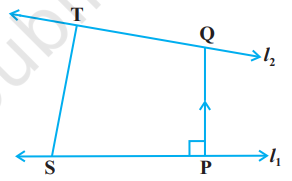
Fig 11.6
$$ \hat{n} = \frac{ \vec{b} _ {1} \times \vec{b} _ {2}}{| \vec{b} _ {1} \times \vec{b} _ {2}|} \tag{3} $$
Then $$ \overrightarrow{{}PQ}=d \hat{n} $$
where, $d$ is the magnitude of the shortest distance vector. Let $\theta$ be the angle between $\overrightarrow{{}ST}$ and $\overrightarrow{{}PQ}$. Then
But $$ \begin{aligned} PQ & = ST|\cos \theta| \\ \cos \theta & = |\frac{\overrightarrow{{}PQ} \cdot \overrightarrow{{}ST}}{|\overrightarrow{{}PQ}||\overrightarrow{{}ST}|}| \\ & = |\frac{d \hat{n} \cdot( \vec{a} _ {2}- \vec{a} _ {1})}{d ST}| \quad(\text{ since } \overrightarrow{{}ST}= \vec{a} _ {2}- \vec{a} _ {1}) \\ & = |\frac{( \vec{b} _ {1} \times \vec{b} _ {2}) \cdot( \vec{a} _ {2}- \vec{a} _ {1})}{ST| \vec{b} _ {1} \times \vec{b} _ {2}|}| \end{aligned} $$
Hence, the required shortest distance is
or $$ \begin{aligned} & d = PQ = ST|\cos \theta| \\ & \boldsymbol{{}d} = |\frac{(\overrightarrow{{}b}_ {1} \times \overrightarrow{{}b}_ {2}) \cdot( \vec{a} _ {2} \times \vec{a} _ {1})}{| \vec{b} _ {1} \times \vec{b} _ {2}|}| \end{aligned} $$
Cartesian form
and $$ l _{1}: \frac{x-x _{1}}{a _{1}}=\frac{y-y _{1}}{b _{1}}=\frac{z-z _{1}}{c _{1}} $$
and $$ l _{2}: \frac{x-x _{2}}{a _{2}}=\frac{y-y _{2}}{b _{2}}=\frac{z-z _{2}}{c _{2}} $$
$$ \frac{\left|\begin{array}{ccc} x _{2}-x _{1} & y _{2}-y _{1} & z _{2}-z _{1} \\ a _{1} & b _{1} & c _{1} \\ a _{2} & b _{2} & c _{2} \end{array}\right|}{\sqrt{\left(b _{1} c _{2}-b _{2} c _{1}\right)^{2}+\left(c _{1} a _{2}-c _{2} a _{1}\right)^{2}+\left(a _{1} b _{2}-a _{2} b _{1}\right)^{2}}} $$
11.5.2 Distance between parallel lines
If two lines $l_1$ and $l_2$ are parallel, then they are coplanar. Let the lines be given by
$$ \begin{align*} & \vec{r}=\vec{a} _{1}+\lambda \vec{b} \tag{1}\\ & \vec{r}=\vec{a} _{2}+\mu \vec{b} \tag{2} \end{align*} $$
where, $ \vec{a} _1$ is the position vector of a point $S$ on $l_1$ and $ \vec{a} _2$ is the position vector of a point $T$ on $l_2$ Fig 11.7.
As $l_1, l_2$ are coplanar, if the foot of the perpendicular from $T$ on the line $l_1$ is $P$, then the distance between the lines $l_1$ and $l_2=|TP|$.
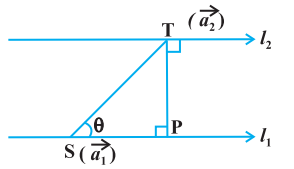
Let $\theta$ be the angle between the vectors $\overrightarrow{{}ST}$ and $\vec{b}$. Then
$$ \vec{b} \times \overrightarrow{{}ST}=(|\vec{b}||\overrightarrow{{}ST}| \sin \theta) \hat{n} \ldots \tag{3} $$
where $\hat{n}$ is the unit vector perpendicular to the plane of the lines $l_1$ and $l_2$.
But $$ \overrightarrow{{}ST} = \vec{a} _2 - \vec{a} _1 $$
Therefore, from (3), we get $$ \begin{matrix} & \quad \vec{b} \times ( \vec{a} _2 - \vec{a} _1) = \vec{b} , |PT| \hat{n} \quad (\text{since } PT = ST \sin \theta) \\ \text{i.e.,} & |\vec{b} \times ( \vec{a} _2 - \vec{a} _1)| = |\vec{b}| , |PT| \cdot 1 \quad (\text{as } |\hat{n}| = 1) \end{matrix} $$
Hence, the distance between the given parallel lines is
$$ d=|\overrightarrow{{}\mathbf{P T}}| = |\frac{\vec{b} \times(\vec{a} _ {2}-\vec{a} _ {1})}{|\vec{b}|}| $$
Example 9 Find the shortest distance between the lines $l_1$ and $l_2$ whose vector equations are
$$ \begin{aligned} & \vec{r} =\hat{i}+\hat{j}+\lambda(2 \hat{i}-\hat{j}+\hat{k}) \\ \text{ and } \qquad& \vec{r} =2 \hat{i}+\hat{j}-\hat{k}+\mu(3 \hat{i}-5 \hat{j}+2 \hat{k}) \end{aligned} $$
Solution Comparing (1) and (2) with $\vec{r} = \vec{a} _ {1} + \lambda \vec{b} _ {1} $ and $ \overrightarrow{{}r} = \overrightarrow{{}a} _ {2} + \mu \overrightarrow{{}b} _ {2} $ respectively, we get
$ \begin{aligned} & a _{1}=\hat{i}+\hat{j}, b _{1}=2 \hat{i}-\hat{j}+\hat{k} \\ & a _{2}=2 \hat{i}+\hat{j}-\hat{k} \text { and } b _{2}=3 \hat{i}-5 \hat{j}+2 \hat{k} \end{aligned} $
Therefore $\qquad a _{2}-a _{1}=\hat{i}-\hat{k}$
and $\qquad b _{1} \times b _{2}=(2 \hat{i}-\hat{j}+\hat{k}) \times(3 \hat{i}-5 \hat{j}+2 \hat{k})$
$$ =\left|\begin{array}{ccc} \hat{i} & \hat{j} & \hat{k} \\ 2 & -1 & 1 \\ 3 & -5 & 2 \end{array}\right|=3 \hat{i}-\hat{j}-7 \hat{k} $$
So, $$ \left|b _{1} \times b _{2}\right|=\sqrt{9+1+49}=\sqrt{59} $$
Hence, the shortest distance between the given lines is given by
$$ d=|\frac{(\overrightarrow{{}b}_ {1} \times \overrightarrow{{}b}_ {2}) \cdot(\overrightarrow{{}a}_ {2}-\overrightarrow{{}a}_ {1})}{|\overrightarrow{{}b}_ {1} \times \overrightarrow{{}b}_ {2}|}|=\frac{|3-0+7|}{\sqrt{59}}=\frac{10}{\sqrt{59}} $$
Example 10 Find the distance between the lines $l_1$ and $l_2$ given by $$ \begin{aligned} & \vec{r}=\hat{i}+2 \hat{j}-4 \hat{k}+\lambda(2 \hat{i}+3 \hat{j}+6 \hat{k}) \\ \text{ and } \qquad& \vec{r}=3 \hat{i}+3 \hat{j}-5 \hat{k}+\mu(2 \hat{i}+3 \hat{j}+6 \hat{k}) \end{aligned} $$
Solution The two lines are parallel (Why?) We have
$$ \overrightarrow{{}a}_ {1}=\hat{i}+2 \hat{j}-4 \hat{k}, \overrightarrow{{}a}_ {2}=3 \hat{i}+3 \hat{j}-5 \hat{k} \text{ and } \vec{b}=2 \hat{i}+3 \hat{j}+6 \hat{k} $$
Therefore, the distance between the lines is given by
$$ \begin{aligned} & d =\left|\frac{\vec{b} \times( \vec{a} _ {2}- \vec{a} _ {1})}{|\vec{b}|}\right| =\left|\frac{ \begin{vmatrix} \hat{i} & \hat{j} & \hat{k} \\ 2 & 3 & 6 \\ 2 & 1 & -1 \end{vmatrix} }{\sqrt{4+9+36}}\right| , \\ &=\frac{|-9 \hat{i}+14 \hat{j}-4 \hat{k}|}{\sqrt{49}}=\frac{\sqrt{293}}{\sqrt{49}}=\frac{\sqrt{293}}{7} \\ \end{aligned} $$
EXERCISE 11.2
1. Show that the three lines with direction cosines
$$ \frac{12}{13}, \frac{-3}{13}, \frac{-4}{13} ; \frac{4}{13}, \frac{12}{13}, \frac{3}{13} ; \frac{3}{13}, \frac{-4}{13}, \frac{12}{13} \text{ are mutually perpendicular. } $$
Show Answer
Solution
Two lines with direction cosines, $l_1, m_1, n_1$ and $l_2, m_2, n_2$, are perpendicular to each other, if $l_1 l_2+m_1 m_2+n_1 n_2=0$
(i) For the lines with direction cosines, $\frac{12}{13}, \frac{-3}{13}, \frac{-4}{13}$ and $\frac{4}{13}, \frac{12}{13}, \frac{3}{13}$, we obtain
$ \begin{aligned} l_1 l_2+m_1 m_2+n_1 n_2 & =\frac{12}{13} \times \frac{4}{13}+(\frac{-3}{13}) \times \frac{12}{13}+(\frac{-4}{13}) \times \frac{3}{13} \\ & =\frac{48}{169}-\frac{36}{169}-\frac{12}{169} \\ & =0 \end{aligned} $
Therefore, the lines are perpendicular.
(ii) For the lines with direction cosines, $\frac{4}{13}, \frac{12}{13}, \frac{3}{13}$ and $\frac{3}{13}, \frac{-4}{13}, \frac{12}{13}$, we obtain
$ \begin{aligned} l_1 l_2+m_1 m_2+n_1 n_2 & =\frac{4}{13} \times \frac{3}{13}+\frac{12}{13} \times(\frac{-4}{13})+\frac{3}{13} \times \frac{12}{13} \\ & =\frac{12}{169}-\frac{48}{169}+\frac{36}{169} \\ & =0 \end{aligned} $
Therefore, the lines are perpendicular.
(iii) For the lines with direction cosines, $\frac{3}{13}, \frac{-4}{13}, \frac{12}{13}$ and $\frac{12}{13}, \frac{-3}{13}, \frac{-4}{13}$, we obtain
$ \begin{aligned} l_1 l_2+m_1 m_2+n_1 n_2 & =(\frac{3}{13}) \times(\frac{12}{13})+(\frac{-4}{13}) \times(\frac{-3}{13})+(\frac{12}{13}) \times(\frac{-4}{13}) \\ & =\frac{36}{169}+\frac{12}{169}-\frac{48}{169} \\ & =0 \end{aligned} $
Therefore, the lines are perpendicular.
Thus, all the lines are mutually perpendicular.
2. Show that the line through the points $(1,-1,2),(3,4,-2)$ is perpendicular to the line through the points $(0,3,2)$ and $(3,5,6)$.
Show Answer
Solution
Let $A B$ be the line joining the points, $(1,-1,2)$ and $(3,4,-2)$, and $C D$ be the line joining the points, $(0,3,2)$ and $(3,5,6)$.
The direction ratios, $a_1, b_1, c_1$, of $AB$ are $(3-1),(4-(-1))$, and $(-2-2)$ i.e., 2,5 , and -4 .
The direction ratios, $a_2, b_2, c_2$, of $C D$ are $(3-0),(5-3)$, and $(6-2)$ i.e., 3,2 , and 4.
$A B$ and $C D$ will be perpendicular to each other, if $a_1 a_2+b_1 b_2+c_1 c_2=0$
$a_1 a_2+b_1 b_2+c_1 c_2=2 \times 3+5 \times 2+(-4) \times 4$
$=6+10-16$
$=0$
Therefore, $A B$ and $C D$ are perpendicular to each other.
3. Show that the line through the points $(4,7,8),(2,3,4)$ is parallel to the line through the points $(-1,-2,1),(1,2,5)$.
Show Answer
Solution
Let $A B$ be the line through the points, $(4,7,8)$ and $(2,3,4)$, and $C D$ be the line through the points, $(-1,-2,1)$ and $(1,2,5)$.
The directions ratios, $a_1, b_1, c_1$, of $A B$ are $(2-4),(3-7)$, and $(4-8)$ i.e., $-2,-4$, and -4 .
The direction ratios, $a_2, b_2, c_2$, of $C D$ are $(1-(-1)),(2-(-2))$, and (5 - 1) i.e., 2 , 4 , and 4. $AB$ will be parallel to $CD$, if $\frac{a_1}{a_2}=\frac{b_1}{b_2}=\frac{c_1}{c_2}$
$\frac{a_1}{a_2}=\frac{-2}{2}=-1$
$\frac{b_1}{b_2}=\frac{-4}{4}=-1$
$\frac{c_1}{c_2}=\frac{-4}{4}=-1$
$\therefore \frac{a_1}{a_2}=\frac{b_1}{b_2}=\frac{c_1}{c_2}$
Thus, $A B$ is parallel to $C D$.
4. Find the equation of the line which passes through the point $(1,2,3)$ and is parallel to the vector $3 \hat{i}+2 \hat{j}-2 \hat{k}$.
Show Answer
Solution
It is given that the line passes through the point $A(1,2,3)$. Therefore, the position vector through A is $\vec{a}=\hat{i}+2 \hat{j}+3 \hat{k}$
$\vec{b}=3 \hat{i}+2 \hat{j}-2 \hat{k}$
It is known that the line which passes through point A and parallel to $\vec{b}$ is given by
$\vec{r}=\vec{a}+\lambda \vec{b}$, where $\lambda$ is a constant.
$\Rightarrow \vec{r}=\hat{i}+2 \hat{j}+3 \hat{k}+\lambda(3 \hat{i}+2 \hat{j}-2 \hat{k})$
This is the required equation of the line.
5. Find the equation of the line in vector and in cartesian form that passes through the point with position vector $2 \hat{i}-j+4 \hat{k}$ and is in the direction $\hat{i}+2 \hat{j}-\hat{k}$.
Show Answer
Solution
It is given that the line passes through the point with position vector $\vec{a}=2 \hat{i}-\hat{j}+4 \hat{k}$
$\vec{b}=\hat{i}+2 \hat{j}-\hat{k}$
It is known that a line through a point with position vector $\vec{a}$ and parallel to $\vec{b}$ is given by the equation, $\vec{r}=\vec{a}+\lambda \vec{b}$
$\Rightarrow \vec{r}=2 \hat{i}-\hat{j}+4 \hat{k}+\lambda(\hat{i}+2 \hat{j}-\hat{k})$
This is the required equation of the line in vector form.
$\vec{r}=x \hat{i}+y \hat{j}+z \hat{k}$
$\Rightarrow x \hat{i}+y \hat{j}+z \hat{k}=(\lambda+2) \hat{i}+(2 \lambda-1) \hat{j}+(-\lambda+4) \hat{k}$
Eliminating $\lambda$, we obtain the Cartesian form equation as
$\frac{x-2}{1}=\frac{y+1}{2}=\frac{z-4}{-1}$
This is the required equation of the given line in Cartesian form.
6. Find the cartesian equation of the line which passes through the point $(-2,4,-5)$ and parallel to the line given by $\frac{x+3}{3}=\frac{y-4}{5}=\frac{z+8}{6}$.
Show Answer
Solution
It is given that the line passes through the point $(-2,4,-5)$ and is parallel to $\frac{x+3}{3}=\frac{y-4}{5}=\frac{z+8}{6}$
The direction ratios of the line, $\frac{x+3}{3}=\frac{y-4}{5}=\frac{z+8}{6}$, are 3,5 , and 6 .
The required line is parallel to $\frac{x+3}{3}=\frac{y-4}{5}=\frac{z+8}{6}$
Therefore, its direction ratios are $3 k, 5 k$, and $6 k$, where $k \neq 0$
It is known that the equation of the line through the point $(x_1, y_1, z_1)$ and with direction
ratios, $a, b, c$, is given by $\frac{x-x_1}{a}=\frac{y-y_1}{b}=\frac{z-z_1}{c}$
Therefore the equation of the required line is
$\frac{x+2}{3 k}=\frac{y-4}{5 k}=\frac{z+5}{6 k}$
$\Rightarrow \frac{x+2}{3}=\frac{y-4}{5}=\frac{z+5}{6}=k$
7. The cartesian equation of a line is $\frac{x-5}{3}=\frac{y+4}{7}=\frac{z-6}{2}$. Write its vector form.
Show Answer
Solution
The Cartesian equation of the line is
$\frac{x-5}{3}=\frac{y+4}{7}=\frac{z-6}{2}$
The given line passes through the point $(5,-4,6)$. The position vector of this point is
$\vec{a}=5 \hat{i}-4 \hat{j}+6 \hat{k}$
Also, the direction ratios of the given line are 3,7 , and 2 .
This means that the line is in the direction of vector, $\vec{b}=3 \hat{i}+7 \hat{j}+2 \hat{k}$
It is known that the line through position vector $\vec{a}$ and in the direction of the $\vec{b}$ is given by the equation, $\vec{r}=\vec{a}+\lambda \vec{b}, \lambda \in R$
$\Rightarrow \vec{r}=(5 \hat{i}-4 \hat{j}+6 \hat{k})+\lambda(3 \hat{i}+7 \hat{j}+2 \hat{k})$
This is the required equation of the given line in vector form.
8. Find the angle between the following pairs of lines:
$\quad\quad$(i) $\vec{r}=2 \hat{i}-5 \hat{j}+\hat{k}+\lambda(3 \hat{i}+2 \hat{j}+6 \hat{k})$ and
$\quad\quad$ $ \vec{r}=7 \hat{i}-6 \hat{k}+\mu(\hat{i}+2 \hat{j}+2 \hat{k}) $
$\quad\quad$(ii) $\vec{r}=3 \hat{i}+\hat{j}-2 \hat{k}+\lambda(\hat{i}-\hat{j}-2 \hat{k})$ and
$\quad\quad$ $ \vec{r}=2 \hat{i}-\hat{j}-56 \hat{k}+\mu(3 \hat{i}-5 \hat{j}-4 \hat{k}) $
Show Answer
Solution
(i) Let $Q$ be the angle between the given lines.
The angle between the given pairs of lines is given by, $\cos Q=|\frac{ \vec{b} _1 \cdot \vec{b} _2}{| \vec{b} _1|| \vec{b} _2|}|$
The given lines are parallel to the vectors, $ \vec{b} _1=3 \hat{i}+2 \hat{j}+6 \hat{k}$ and $ \vec{b} _2=\hat{i}+2 \hat{j}+2 \hat{k}$, respectively.
$ \begin{aligned} \therefore| \vec{b} _1| & =\sqrt{3^{2}+2^{2}+6^{2}}=7 \\ | \vec{b} _2| & =\sqrt{(1)^{2}+(2)^{2}+(2)^{2}}=3 \\ \vec{b} _1 \cdot \vec{b} _2 & =(3 \hat{i}+2 \hat{j}+6 \hat{k}) \cdot(\hat{i}+2 \hat{j}+2 \hat{k}) \\ & =3 \times 1+2 \times 2+6 \times 2 \\ & =3+4+12 \\ & =19 \end{aligned} $
$\Rightarrow \cos Q=\frac{19}{7 \times 3}$
$\Rightarrow Q=\cos ^{-1}(\frac{19}{21})$
(ii) The given lines are parallel to the vectors, $ \vec{b} _1=\hat{i}-\hat{j}-2 \hat{k}$ and $ \vec{b} _2=3 \hat{i}-5 \hat{j}-4 \hat{k}$, respectively.
$ \begin{aligned} & \therefore| \vec{b} _1|=\sqrt{(1)^{2}+(-1)^{2}+(-2)^{2}}=\sqrt{6} \\ & | \vec{b} _2|=\sqrt{(3)^{2}+(-5)^{2}+(-4)^{2}}=\sqrt{50}=5 \sqrt{2} \\ & \vec{b} _1 \cdot \vec{b} _2=(\hat{i}-\hat{j}-2 \hat{k}) \cdot(3 \hat{i}-5 \hat{j}-4 \hat{k}) \\ & =1 \cdot 3-1(-5)-2(-4) \\ & =3+5+8 \\ & =16 \\ & \cos Q=|\frac{ \vec{b} _1 \cdot \vec{b} _2}{| \vec{b} _1|| \vec{b} _2|}| \\ & \Rightarrow \cos Q=\frac{16}{\sqrt{6} \cdot 5 \sqrt{2}}=\frac{16}{\sqrt{2} \cdot \sqrt{3} \cdot 5 \sqrt{2}}=\frac{16}{10 \sqrt{3}} \\ & \Rightarrow \cos Q=\frac{8}{5 \sqrt{3}} \\ & \Rightarrow Q=\cos ^{-1}(\frac{8}{5 \sqrt{3}}) \end{aligned} $
9. Find the angle between the following pair of lines:
$\quad\quad$(i) $\frac{x-2}{2}=\frac{y-1}{5}=\frac{z+3}{-3}$ and $\frac{x+2}{-1}=\frac{y-4}{8}=\frac{z-5}{4}$
$\quad\quad$(ii) $\frac{x}{2}=\frac{y}{2}=\frac{z}{1}$ and $\frac{x-5}{4}=\frac{y-2}{1}=\frac{z-3}{8}$
Show Answer
Solution
Let $ \vec{b} _1$ and $ \vec{b} _2$ be the vectors parallel to the pair of lines,
$ \begin{aligned} & \frac{x-2}{2}=\frac{y-1}{5}=\frac{z+3}{-3} \text{ and } \frac{x+2}{-1}=\frac{y-4}{8}=\frac{z-5}{4} \text{, respectively. } \\ & \therefore \vec{b} _1=2 \hat{i}+5 \hat{j}-3 \hat{k} \text{ and } \vec{b} _2=-\hat{i}+8 \hat{j}+4 \hat{k} \\ & | \vec{b} _1|=\sqrt{(2)^{2}+(5)^{2}+(-3)^{2}}=\sqrt{38} \\ & | \vec{b} _2|=\sqrt{(-1)^{2}+(8)^{2}+(4)^{2}}=\sqrt{81}=9 \\ & \vec{b} _1 \cdot \vec{b} _2=(2 \hat{i}+5 \hat{j}-3 \hat{k}) \cdot(-\hat{i}+8 \hat{j}+4 \hat{k}) \\ & =2(-1)+5 \times 8+(-3) \cdot 4 \\ & =-2+40-12 \\ & =26 \end{aligned} $
The angle, $Q$, between the given pair of lines is given by the relation,
$ \begin{aligned} & \cos Q=|\frac{ \vec{b} _1 \cdot \vec{b} _2}{| \vec{b} _1|| \vec{b} _2|}| \\ & \Rightarrow \cos Q=\frac{26}{9 \sqrt{38}} \\ & \Rightarrow Q=\cos ^{-1}(\frac{26}{9 \sqrt{38}}) \end{aligned} $
(ii) Let $ \vec{b} _1, \vec{b} _2$ be the vectors parallel to the given pair of lines, $\frac{x}{2}=\frac{y}{2}=\frac{z}{1}$ and $\frac{x-5}{4}=\frac{y-5}{1}=\frac{z-3}{8}$, respectively.
$ \begin{aligned} & \vec{b} _1=2 \hat{i}+2 \hat{j}+\hat{k} \\ & \vec{b} _2=4 \hat{i}+\hat{j}+8 \hat{k} \\ & \therefore| \vec{b} _1|=\sqrt{(2)^{2}+(2)^{2}+(1)^{2}}=\sqrt{9}=3 \\ & | \vec{b} _2|=\sqrt{4^{2}+1^{2}+8^{2}}=\sqrt{81}=9 \\ & \vec{b} _1 \cdot \vec{b} _2=(2 \hat{i}+2 \hat{j}+\hat{k}) \cdot(4 \hat{i}+\hat{j}+8 \hat{k}) \\ & \quad=2 \times 4+2 \times 1+1 \times 8 \\ & \quad=8+2+8 \\ & \quad=18 \end{aligned} $
If $Q$ is the angle between the given pair of lines, then $\cos Q=|\frac{ \vec{b} _1 \cdot \vec{b} _2}{| \vec{b} _1|| \vec{b} _2|}|$
$\Rightarrow \cos Q=\frac{18}{3 \times 9}=\frac{2}{3}$
$\Rightarrow Q=\cos ^{-1}(\frac{2}{3})$
10. Find the values of $p$ so that the lines $\frac{1-x}{3}=\frac{7 y-14}{2 p}=\frac{z-3}{2}$ and $\frac{7-7 x}{3 p}=\frac{y-5}{1}=\frac{6-z}{5}$ are at right angles.
Show Answer
Solution
The given equations can be written in the standard form as
$ \frac{x-1}{-3}=\frac{y-2}{\frac{2 p}{7}}=\frac{z-3}{2} \text{ and } \frac{x-1}{\frac{-3 p}{7}}=\frac{y-5}{1}=\frac{z-6}{-5} $
The direction ratios of the lines are $-3, \frac{2 p}{7}, 2$ and $\frac{-3 p}{7}, 1,-5$ respectively.
Two lines with direction ratios, $a_1, b_1, c_1$ and $a_2, b_2, c_2$, are perpendicular to each other, if $a_1 a_2+b_1 b_2+c_1 c_2=0$ $\therefore(-3) \cdot(\frac{-3 p}{7})+(\frac{2 p}{7}) \cdot(1)+2 \cdot(-5)=0$
$\Rightarrow \frac{9 p}{7}+\frac{2 p}{7}=10$
$\Rightarrow 11 p=70$
$\Rightarrow p=\frac{70}{11}$
Thus, the value of $p$ is $\frac{70}{11}$.
11. Show that the lines $\frac{x-5}{7}=\frac{y+2}{-5}=\frac{z}{1}$ and $\frac{x}{1}=\frac{y}{2}=\frac{z}{3}$ are perpendicular to each other.
Show Answer
Solution
The equations of the given lines are $\frac{x-5}{7}=\frac{y+2}{-5}=\frac{z}{1}$ and $\frac{x}{1}=\frac{y}{2}=\frac{z}{3}$
The direction ratios of the given lines are $7,-5,1$ and $1,2,3$ respectively.
Two lines with direction ratios, $a_1, b_1, c_1$ and $a_2, b_2, c_2$, are perpendicular to each other, if $a_1 a_2+b_1 b_2+c_1 c_2=0$
$\therefore 7 \times 1+(-5) \times 2+1 \times 3$
$=7-10+3$
$=0$
Therefore, the given lines are perpendicular to each other.
12. Find the shortest distance between the lines
$\quad\quad$ $ \begin{aligned} & \vec{r}=(\hat{i}+2 \hat{j}+\hat{k})+\lambda(\hat{i}-\hat{j}+\hat{k}) \text{ and } \\ & \vec{r}=2 \hat{i}-\hat{j}-\hat{k}+\mu(2 \hat{i}+\hat{j}+2 \hat{k}) \end{aligned} $
Show Answer
Solution
The equations of the given lines are
$\vec{r}=(\hat{i}+2 \hat{j}+\hat{k})+\lambda(\hat{i}-\hat{j}+\hat{k})$
$\vec{r}=2 \hat{i}-\hat{j}-\hat{k}+\mu(2 \hat{i}+\hat{j}+2 \hat{k})$
It is known that the shortest distance between the lines, $\vec{r}= \vec{a} _1+\lambda \vec{b} _1$ and $\vec{r}= \vec{a} _2+\mu \vec{b} _2$, is given by,
$d=|\frac{( \vec{b} _1 \times \vec{b} _2) \cdot( \vec{a} _2- \vec{a} _2)}{|\overrightarrow{{}b_1} \times \vec{b} _2|}|$
Comparing the given equations, we obtain
$ \begin{aligned} & \vec{a} _1=\hat{i}+2 \hat{j}+\hat{k} \\ & \vec{b} _1=\hat{i}-\hat{j}+\hat{k} \\ & \vec{a} _2=2 \hat{i}-\hat{j}-\hat{k} \\ & \vec{b} _2=2 \hat{i}+\hat{j}+2 \hat{k} \\ & \vec{a} _2- \vec{a} _1=(2 \hat{i}-\hat{j}-\hat{k})-(\hat{i}+2 \hat{j}+\hat{k})=\hat{i}-3 \hat{j}-2 \hat{k} \\ & \vec{b} _1 \times \vec{b} _2= \begin{vmatrix} \hat{i} & \hat{j} & \hat{k} \\ 1 & -1 & 1 \\ 2 & 1 & 2 \end{vmatrix} \\ & \vec{b} _1 \times \vec{b} _2=(-2-1) \hat{i}-(2-2) \hat{j}+(1+2) \hat{k}=-3 \hat{i}+3 \hat{k} \\ & \Rightarrow| \vec{b} _1 \times \vec{b} _2|=\sqrt{(-3)^{2}+(3)^{2}}=\sqrt{9+9}=\sqrt{18}=3 \sqrt{2} \end{aligned} $
Substituting all the values in equation (1), we obtain
$ \begin{aligned} & d=|\frac{(-3 \hat{i}+3 \hat{k}) \cdot(\hat{i}-3 \hat{j}-2 \hat{k})}{3 \sqrt{2}}| \\ & \Rightarrow d=|\frac{-3.1+3(-2)}{3 \sqrt{2}}| \\ & \Rightarrow d=|\frac{-9}{3 \sqrt{2}}| \\ & \Rightarrow d=\frac{3}{\sqrt{2}}=\frac{3 \times \sqrt{2}}{\sqrt{2} \times \sqrt{2}}=\frac{3 \sqrt{2}}{2} \end{aligned} $
Therefore, the shortest distance between the two lines is $\frac{3 \sqrt{2}}{2}$ units.
13. Find the shortest distance between the lines
$\quad\quad$ $\frac{x+1}{7}=\frac{y+1}{-6}=\frac{z+1}{1}$ and $\frac{x-3}{1}=\frac{y-5}{-2}=\frac{z-7}{1}$
Show Answer
Solution
The given lines are $\frac{x+1}{7}=\frac{y+1}{-6}=\frac{z+1}{1}$ and $\frac{x-3}{1}=\frac{y-5}{-2}=\frac{z-7}{1}$
It is known that the shortest distance between the two lines,
$\frac{x-x_1}{a_1}=\frac{y-y_1}{b_1}=\frac{z-z_1}{c_1}$ and $\frac{x-x_2}{a_2}=\frac{y-y_2}{b_2}=\frac{z-z_2}{c_2}$, is given by,
$d=\frac{ \begin{vmatrix} x_2-x_1 & y_2-y_1 & z_2-z_1 \\ a_1 & b_1 & c_1 \\ a_2 & b_2 & c_2\end{vmatrix} }{\sqrt{(b_1 c_2-b_2 c_1)^{2}+(c_1 a_2-c_2 a_1)^{2}+(a_1 b_2-a_2 b_1)^{2}}}$
Comparing the given equations, we obtain
$ \begin{aligned} & x_1=-1, y_1=-1, z_1=-1 \\ & a_1=7, \quad b_1=-6, c_1=1 \\ & x_2=3, \quad y_2=5, z_2=7 \\ & a_2=1, \quad b_2=-2, c_2=1 \\ & \text{ Then, } \begin{vmatrix} x_2-x_1 & y_2-y_1 & z_2-z_1 \\ a_1 & b_1 & c_1 \\ a_2 & b_2 & c_2 \end{vmatrix} = \begin{vmatrix} 4 & 6 & 8 \\ 7 & -6 & 1 \\ 1 & -2 & 1 \end{vmatrix} \\ & =4(-6+2)-6(7-1)+8(-14+6) \\ & =-16-36-64 \\ & =-116 \\ & \Rightarrow \sqrt{(b_1 c_2-b_2 c_1)^{2}+(c_1 a_2-c_2 a_1)^{2}+(a_1 b_2-a_2 b_1)^{2}}=\sqrt{(-6+2)^{2}+(1+7)^{2}+(-14+6)^{2}} \\ & =\sqrt{16+36+64} \\ & =\sqrt{116} \\ & =2 \sqrt{29} \end{aligned} $
Substituting all the values in equation (1), we obtain
$d=\frac{-116}{2 \sqrt{29}}=\frac{-58}{\sqrt{29}}=\frac{-2 \times 29}{\sqrt{29}}=-2 \sqrt{29}$
Since distance is always non-negative, the distance between the given lines is $2 \sqrt{29}$ units.
14. Find the shortest distance between the lines whose vector equations are $\vec{r}=(\hat{i}+2 \hat{j}+3 \hat{k})+\lambda(\hat{i}-3 \hat{j}+2 \hat{k})$ and $\vec{r}=4 \hat{i}+5 \hat{j}+6 \hat{k}+\mu(2 \hat{i}+3 \hat{j}+\hat{k})$
Show Answer
Solution
The given lines are $\vec{r}=\hat{i}+2 \hat{j}+3 \hat{k}+\lambda(\hat{i}-3 \hat{j}+2 \hat{k})$ and $\vec{r}=4 \hat{i}+5 \hat{j}+6 \hat{k}+\mu(2 \hat{i}+3 \hat{j}+\hat{k})$
It is known that the shortest distance between the lines, $\vec{r}= \vec{a} _1+\lambda \vec{b} _1$ and $\vec{r}= \vec{a} _2+\mu \vec{b} _2$, is given by, $d=|\frac{( \vec{b} _1 \times \vec{b} _2) \cdot( \vec{a} _2- \vec{a} _2)}{| \vec{b} _1 \times \vec{b} _2|}|$
Comparing the given equations with $\vec{r}= \vec{a} _1+\lambda \vec{b} _1$ and $\vec{r}= \vec{a} _2+\mu \vec{b} _2$, we obtain
$ \begin{aligned} & \vec{a} _1=\hat{i}+2 \hat{j}+3 \hat{k} \\ & \vec{b} _1=\hat{i}-3 \hat{j}+2 \hat{k} \\ & \vec{a} _2=4 \hat{i}+5 \hat{j}+6 \hat{k} \\ & \vec{b} _2=2 \hat{i}+3 \hat{j}+\hat{k} \\ & \vec{a} _2- \vec{a} _1=(4 \hat{i}+5 \hat{j}+6 \hat{k})-(\hat{i}+2 \hat{j}+3 \hat{k})=3 \hat{i}+3 \hat{j}+3 \hat{k} \\ & \vec{b} _1 \times \vec{b} _2= \begin{vmatrix} \hat{i} & \hat{j} & \hat{k} \\ 1 & -3 & 2 \\ 2 & 3 & 1 \end{vmatrix} =(-3-6) \hat{i}-(1-4) \hat{j}+(3+6) \hat{k}=-9 \hat{i}+3 \hat{j}+9 \hat{k} \\ & \Rightarrow| \vec{b} _1 \times \vec{b} _2|=\sqrt{(-9)^{2}+(3)^{2}+(9)^{2}}=\sqrt{81+9+81}=\sqrt{171}=3 \sqrt{19} \\ & ( \vec{b} _1 \times \vec{b} _2) \cdot( \vec{a} _2- \vec{a} _1)=(-9 \hat{i}+3 \hat{j}+9 \hat{k}) \cdot(3 \hat{i}+3 \hat{j}+3 \hat{k}) \\ & =-9 \times 3+3 \times 3+9 \times 3 \\ & =9 \end{aligned} $
Substituting all the values in equation (1), we obtain
$d=|\frac{9}{3 \sqrt{19}}|=\frac{3}{\sqrt{19}}$
Therefore, the shortest distance between the two given lines is $\frac{3}{\sqrt{19}}$ units.
15. Find the shortest distance between the lines whose vector equations are $\vec{r}=(1-t) \hat{i}+(t-2) \hat{j}+(3-2 t) \hat{k}$ and $\vec{r}=(s+1) \hat{i}+(2 s-1) \hat{j}-(2 s+1) \hat{k}$
Show Answer
Solution
The given lines are $\vec{r}=(1-t) \hat{i}+(t-2) \hat{j}+(3-2 t) \hat{k}$
$\Rightarrow \vec{r}=(\hat{i}-2 \hat{j}+3 \hat{k})+t(-\hat{i}+\hat{j}-2 \hat{k})$
$\vec{r}=(s+1) \hat{i}+(2 s-1) \hat{j}-(2 s+1) \hat{k}$
$\Rightarrow \vec{r}=(\hat{i}-\hat{j}+\hat{k})+s(\hat{i}+2 \hat{j}-2 \hat{k})$
It is known that the shortest distance between the lines, $\vec{r}= \vec{a} _1+\lambda \vec{b} _1$ and $\vec{r}= \vec{a} _2+\mu \vec{b} _2$, is given by,
$d=|\frac{( \vec{b} _1 \times \vec{b} _2) \cdot( \vec{a} _2- \vec{a} _2)}{| \vec{b} _1 \times \vec{b} _2|}|$
For the given equations,
$ \vec{a} _1=\hat{i}-2 \hat{j}+3 \hat{k}$
$ \vec{b} _1=-\hat{i}+\hat{j}-2 \hat{k}$
$ \vec{a} _2=\hat{i}-\hat{j}-\hat{k}$
$ \vec{b} _2=\hat{i}+2 \hat{j}-2 \hat{k}$
$ \vec{a} _2- \vec{a} _1=(\hat{i}-\hat{j}-\hat{k})-(\hat{i}-2 \hat{j}+3 \hat{k})=\hat{j}-4 \hat{k}$
$ \vec{b} _1 \times \vec{b} _2= \begin{vmatrix} \hat{i} & \hat{j} & \hat{k} \\ -1 & 1 & -2 \\ 1 & 2 & -2\end{vmatrix} =(-2+4) \hat{i}-(2+2) \hat{j}+(-2-1) \hat{k}=2 \hat{i}-4 \hat{j}-3 \hat{k}$
$\Rightarrow| \vec{b} _1 \times \vec{b} _2|=\sqrt{(2)^{2}+(-4)^{2}+(-3)^{2}}=\sqrt{4+16+9}=\sqrt{29}$
$\therefore( \vec{b} _1 \times \vec{b} _2) \cdot( \vec{a} _2- \vec{a} _1)=(2 \hat{i}-4 \hat{j}-3 \hat{k}) \cdot(\hat{j}-4 \hat{k})=-4+12=8$
Substituting all the values in equation (3), we obtain
$d=|\frac{8}{\sqrt{29}}|=\frac{8}{\sqrt{29}}$
Therefore, the shortest distance between the lines is $\frac{8}{\sqrt{29}}$ units.
Miscellaneous Exercise on Chapter 11
1. Find the angle between the lines whose direction ratios are $a, b, c$ and $b-c, c-a, a-b$.
Show Answer
Solution
The angle $Q$ between the lines with direction cosines, $a, b, c$ and $b-c, c-a$, $a-b$, is given by,
$\cos Q=|\frac{a(b-c)+b(c-a)+c(a-b)}{\sqrt{a^{2}+b^{2}+c^{2}}+\sqrt{(b-c)^{2}+(c-a)^{2}+(a-b)^{2}}}|$
$\Rightarrow \cos Q=0$
$\Rightarrow Q=\cos ^{-1} 0$
$\Rightarrow Q=90^{\circ}$
Thus, the angle between the lines is $90^{\circ}$.
2. Find the equation of a line parallel to $x$-axis and passing through the origin.
Show Answer
Solution
The line parallel to $x$-axis and passing through the origin is $x$-axis itself.
Let $A$ be a point on $x$-axis. Therefore, the coordinates of $A$ are given by $(a, 0,0)$, where
$a \in R$.
Direction ratios of $OA$ are $(a, 0,0)$
The equation of $O A$ is given by,
$\frac{x-0}{a}=\frac{y-0}{0}=\frac{z-0}{0}$
$\Rightarrow \frac{x}{1}=\frac{y}{0}=\frac{z}{0}=a$
Thus, the equation of line parallel to $x$-axis and passing through origin is $\frac{x}{1}=\frac{y}{0}=\frac{z}{0}$
3. If the lines $\frac{x-1}{-3}=\frac{y-2}{2 k}=\frac{z-3}{2}$ and $\frac{x-1}{3 k}=\frac{y-1}{1}=\frac{z-6}{-5}$ are perpendicular, find the value of $k$.
Show Answer
Solution
The direction of ratios of the lines, $\frac{x-1}{-3}=\frac{y-2}{2 k}=\frac{z-3}{2}$ and $\frac{x-1}{3 k}=\frac{y-1}{1}=\frac{z-6}{-5}$, are -3 , $2 k, 2$ and $3 k, 1,-5$ respectively.
It is known that two lines with direction ratios, $a_1, b_1, c_1$ and $a_2, b_2, c_2$, are perpendicular, if $a_1 a_2+b_1 b_2+c_1 c_2=0$
$\therefore-3(3 k)+2 k \times 1+2(-5)=0$
$\Rightarrow-9 k+2 k-10=0$
$\Rightarrow 7 k=-10$
$\Rightarrow k=\frac{-10}{7}$
Therefore, for $k=-\frac{10}{7}$, the given lines are perpendicular to each other.
4. Find the shortest distance between lines $\vec{r}=6 \hat{i}+2 \hat{j}+2 \hat{k}+\lambda(\hat{i}-2 \hat{j}+2 \hat{k})$ and $\vec{r}=-4 \hat{i}-\hat{k}+\mu(3 \hat{i}-2 \hat{j}-2 \hat{k})$.
Show Answer
Solution
The given lines are
$\vec{r}=6 \hat{i}+2 \hat{j}+2 \hat{k}+\lambda(\hat{i}-2 \hat{j}+2 \hat{k})$
$\vec{r}=-4 \hat{i}-\hat{k}+\mu(3 \hat{i}-2 \hat{j}-2 \hat{k})$
It is known that the shortest distance between two lines, $\vec{r}= \vec{a} _1+\lambda \vec{b} _1$ and $\vec{r}= \vec{a} _2+\lambda \vec{b} _2$, is given by
$d=|\frac{( \vec{b} _1 \times \vec{b} _2) \cdot( \vec{a} _2- \vec{a} _1)}{| \vec{b} _1 \times \vec{b} _2|}|$
Comparing $\vec{r}= \vec{a} _1+\lambda \vec{b} _1$ and $\vec{r}= \vec{a} _2+\lambda \vec{b} _2$ to equations (1) and (2), we obtain
$ \vec{a} _1=6 \hat{i}+2 \hat{j}+2 \hat{k}$
$ \vec{b} _1=\hat{i}-2 \hat{j}+2 \hat{k}$
$ \vec{a} _2=-4 \hat{i}-\hat{k}$
$ \vec{b} _2=3 \hat{i}-2 \hat{j}-2 \hat{k}$
$\Rightarrow \vec{a} _2- \vec{a} _1=(-4 \hat{i}-\hat{k})-(6 \hat{i}+2 \hat{j}+2 \hat{k})=-10 \hat{i}-2 \hat{j}-3 \hat{k}$
$ \begin{aligned} & \Rightarrow \vec{b} _1 \times \vec{b} _2= \begin{vmatrix} \hat{i} & \hat{j} & \hat{k} \\ 1 & -2 & 2 \\ 3 & -2 & -2 \end{vmatrix} =(4+4) \hat{i}-(-2-6) \hat{j}+(-2+6) \hat{k}=8 \hat{i}+8 \hat{j}+4 \hat{k} \\ & \therefore| \vec{b} _1 \times \vec{b} _2|=\sqrt{(8)^{2}+(8)^{2}+(4)^{2}}=12 \end{aligned} $
$ ( \vec{b} _1 \times \vec{b} _2) \cdot( \vec{a} _2- \vec{a} _1)=(8 \hat{i}+8 \hat{j}+4 \hat{k}) \cdot(-10 \hat{i}-2 \hat{j}-3 \hat{k})=-80-16-12=-108 $
Substituting all the values in equation (1), we obtain
$d=|\frac{-108}{12}|=9$
Therefore, the shortest distance between the two given lines is 9 units.
5. Find the vector equation of the line passing through the point $(1,2,-4)$ and perpendicular to the two lines:
$\quad\quad$ $ \frac{x-8}{3}=\frac{y+19}{-16}=\frac{z-10}{7} \text{ and } \frac{x-15}{3}=\frac{y-29}{8}=\frac{z-5}{-5} . $
Show Answer
Solution
Key concept $\rightarrow$ Equation of line passing through $\left(x_1, y_1, z_1\right)$ and having $D R$ ’s $(a, b, c)$ is given by
$ \begin{aligned} & \frac{x-x_1}{a}=\frac{y-y_1}{b}=\frac{z-z_1}{c} \\ \end{aligned} $
$ \begin{aligned} & (1,2,-4) \ \end{aligned} $
$ \begin{aligned} & \frac{x-1}{a}=\frac{y-2}{b}=\frac{z+4}{c} \end{aligned} $
$\begin{aligned} & a_1, b_1, c_1 \text { and } a_2, b_2, c_2 \\ & a_1 a_1+b_1 b_2+c_1 c_2=0 \\ & 3 \hat{i}-16 \hat{j}+7 \hat{k} \text { and } 3 \hat{i}+8 \hat{j}-5 \hat{k} \\ & (3 \hat{i}-16 \hat{j}+7 \hat{k}) \times(3 \hat{\imath}+8 \hat{j}-5 \hat{k})=\left|\begin{array}{ccc}\hat{i} & \hat{j} & \hat{k} \\ 3 & -16 & 7 \\ 3 & 8 & -5\end{array}\right| \\ & =\hat{i}(80-56)-\hat{j}(-15-21)+\hat{k}(24+48) \\ & -24 \hat{i}+36 \hat{j}+72 \hat{k} \rightarrow(24,36,72) \\ & \frac{x-1}{24}=\frac{y-2}{36}=\frac{z+4}{72} \Rightarrow \frac{x-1}{2}=\frac{y-2}{3}=\frac{z+4}{6} \\ & \end{aligned}$
$\vec{r}=\hat{i}+2 \hat{j}-4 \hat{k}+\lambda(2 \hat{i}+3 \hat{j}+6 \hat{k})$
Summary
-
Direction cosines of a line are the cosines of the angles made by the line with the positive directions of the coordinate axes.
-
If $l, m, n$ are the direction cosines of a line, then $l^{2}+m^{2}+n^{2}=1$.
-
Direction cosines of a line joining two points $P(x_1, y_1, z_1)$ and $Q(x_2, y_2, z_2)$ are
-
$ \frac{x_2-x_1}{PQ}, \frac{y_2-y_1}{PQ}, \frac{z_2-z_1}{PQ} $
where $PQ=\sqrt{(x_2-x_1)^{2}+(y_2-y_1)^{2}+(z_2-z_1)^{2}}$
- $\Delta$ Direction ratios of a line are the numbers which are proportional to the direction cosines of a line.
- If $l, m, n$ are the direction cosines and $a, b, c$ are the direction ratios of a line then
$$ l=\frac{a}{\sqrt{a^{2}+b^{2}+c^{2}}} ; m=\frac{b}{\sqrt{a^{2}+b^{2}+c^{2}}} ; n=\frac{c}{\sqrt{a^{2}+b^{2}+c^{2}}} $$
- Skew lines are lines in space which are neither parallel nor intersecting. They lie in different planes.
- Angle between skew lines is the angle between two intersecting lines drawn from any point (preferably through the origin) parallel to each of the skew lines.
- If $l_1, m_1, n_1$ and $l_2, m_2, n_2$ are the direction cosines of two lines; and $\theta$ is the acute angle between the two lines; then
$$ \cos \theta=|l_1 l_2+m_1 m_2+n_1 n_2| $$
If $a_1, b_1, c_1$ and $a_2, b_2, c_2$ are the direction ratios of two lines and $\theta$ is the acute angle between the two lines; then
$$ \cos \theta=|\frac{a_1 a_2+b_1 b_2+c_1 c_2}{\sqrt{a_1^{2}+b_1^{2}+c_1^{2}} \sqrt{a_2^{2}+b_2^{2}+c_2^{2}}}| $$
-
Vector equation of a line that passes through the given point whose position vector is $\vec{a}$ and parallel to a given vector $\vec{b}$ is $\vec{r}=\vec{a}+\lambda \vec{b}$.
-
Equation of a line through a point $(x_1, y_1, z_1)$ and having direction cosines $l, m, n$ is $ \frac{x-x_1}{l}=\frac{y-y_1}{m}=\frac{z-z_1}{n} $
-
The vector equation of a line which passes through two points whose position vectors are $\vec{a}$ and $\vec{b}$ is $\vec{r}=\vec{a}+\lambda(\vec{b}-\vec{a})$.
-
$\Delta$ If $\theta$ is the acute angle between $\vec{r}= \vec{a} _ {1}+\lambda \vec{b} _ {1}$ and $\vec{r}= \vec{a} _ {2}+\lambda \vec{b} _ {2}$, then $\cos \theta=|\frac{ \vec{b} _ {1} \cdot \vec{b} _ {2}}{| \vec{b} _ {1}|| \vec{b} _ {2}|}|$
-
$\checkmark$ If $\frac{x-x_1}{l_1}=\frac{y-y_1}{m_1}=\frac{z-z_1}{n_1}$ and $\frac{x-x_2}{l_2}=\frac{y-y_2}{m_2}=\frac{z-z_2}{n_2}$
-
are the equations of two lines, then the acute angle between the two lines is given by $\cos \theta=|l_1 l_2+m_1 m_2+n_1 n_2|$.
-
Shortest distance between two skew lines is the line segment perpendicular to both the lines.
-
Shortest distance between $\vec{r}= \vec{a} _ {1}+\lambda \vec{b} _ {1}$ and $\vec{r}= \vec{a} _ {2}+\mu \vec{b} _ {2}$ is
$$ |\frac{( \vec{b} _ {1} \times \vec{b} _ {2}) \cdot( \vec{a} _ {2}- \vec{a} _ {1})}{| \vec{b} _ {1} \times \vec{b} _ {2}|}| $$
- Shortest distance between the lines: $\frac{x-x_1}{a_1}=\frac{y-y_1}{b_1}=\frac{z-z_1}{c_1}$ and $ \frac{x-x_2}{a_2}=\frac{y-y_2}{b_2}=\frac{z-z_2}{c_2} \text{ is } $
$$ \frac{ \begin{vmatrix} x_2-x_1 & y_2-y_1 & z_2-z_1 \\ a_1 & b_1 & c_1 \\ a_2 & b_2 & c_2 \end{vmatrix} }{\sqrt{(b_1 c_2-b_2 c_1)^{2}+(c_1 a_2-c_2 a_1)^{2}+(a_1 b_2-a_2 b_1)^{2}}} $$
Distance between parallel lines $\vec{r}= \vec{a} _ {1}+\lambda \vec{b}$ and $\vec{r}= \vec{a} _ {2}+\mu \vec{b}$ is
$$|\frac{\vec{b} \times( \vec{a} _ {2}- \vec{a} _ {1})}{|\vec{b}|}|$$










